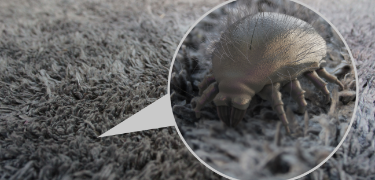House dust mite allergy is the most common cause of year-round allergy symptoms.1 This allergy has been on the rise in recent years, all due to energy efficient housing, reduced ventilation, increased use of central heating, and widespread use of carpets.2 It creates the ideal living environment for house dust mites, which prefer high temperatures and humidity.2 New Zealand, can have a particular problem with dust mites because they thrive in temperatures over 20°C and humidity over 75%.3,4
What are dust mites, why do they cause allergies, and can I get rid of them?
What are the typical dust mite allergy symptoms?
Typical symptoms of dust mite allergy are the same as hay fever and pet allergy, such as itchy nose, runny nose, stuffy nose, sneezing, red, itching and watery eyes.1,6 Mite allergies are not seasonal.6 Dust mite allergy sufferers have symptoms all year round because they are exposed to allergens every day of the year.1
How is an allergy to dust mites treated?
While it’s impossible to completely avoid dust mites, here are some tips to help reduce the number living in your home:6
- Treat any dampness and improve the ventilation throughout your house.6 If the humidity drops below 50%, dust mites will dry out and die.2
- If you’re renovating your home, consider alternatives to wall-to-wall carpeting and use vacuums with built-in HEPA filters.6
- Use anti-mite covers on mattresses, pillows, and beds.6
- Wash all bedding regularly in warm water.6
- Bedspreads, decorative pillows, and stuffed animals placed in or on your bed should also be cleaned regularly.7
Despite all these prevention and avoidance strategies, it is impossible to avoid all house dust mite allergens. Several treatment options are available, including anti-allergy tablets (such as RAZENE), nasal sprays, and eye drops.1,8 Speak to your pharmacist or doctor if you have symptoms and are unsure about which treatment option will be best for you.
Related Articles

Learn more about which moulds are safe and hazardous. Explore what causes it to grow in your home and tips to try and eliminate it.
Know More
Could your best friend be causing your allergy symptoms to get worse? Read more on how you can reduce them.
Know More
In this article, we'll explore different options if you have a cat allergy but choose to live with a furry friend.
Know More-
References
- Asthma and Allergy Foundation of America (AAFA). Dust mite allergy. Accessed 21 March 2025. Available from: https://aafa.org/allergies/types-of-allergies/insect-allergy/dust-mite-allergy/
- Acevedo N, Zakzuk J, Caraballo L. House Dust Mite Allergy Under Changing Environments. Allergy Asthma Immunol Res. 2019;11(4):450-469. doi:10.4168/aair.2019.11.4.450
- Allergy New Zealand. House Dust Mites. Accessed 21 March 2025. Available from: https://www.allergy.org.nz/conditions/environmental-allergies/seed/
- Current Results. Annual average humidity in New Zealand. Accessed 21 March 2025. Available from: https://www.currentresults.com/Weather/New-Zealand/humidity-annual-average.php
- Asthma and Respiratory Foundation NZ. House dust mites: fact sheet. Accessed 21 March 2025. Available from: https://www.asthmafoundation.org.nz/assets/documents/House-Dust-Mites-Fact-Sheet.pdf
- Healthify. Allergy due to dust mites. Accessed 21 March 2025. Available from: https://healthify.nz/health-a-z/a/allergy-dust-mites
- Asthma and Allergy Foundation of America (AAFA). How Can I Control Indoor Allergens and Improve Indoor Air Quality? Accessed 21 March 2025. Available from: https://aafa.org/allergies/prevent-allergies/control-indoor-allergens/
- RAZENE Data Sheet. Available from: https://www.medsafe.govt.nz/profs/datasheet/r/razenetab.pdf
Most Viewed Articles
![]() This Section is a horizontal scrollbar
This Section is a horizontal scrollbar





